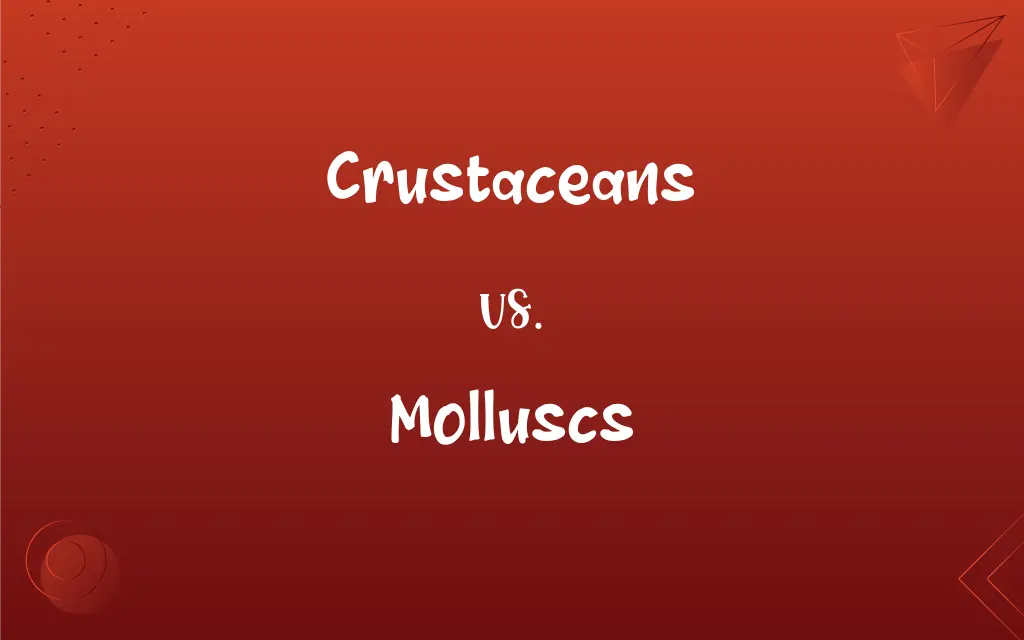Crustaceans vs. Molluscs: What's the Difference?
Edited by Aimie Carlson || By Janet White || Updated on November 18, 2023
Crustaceans are hard-shelled arthropods like crabs, while molluscs are a diverse group with soft bodies, often housed in shells, such as snails.

Key Differences
Crustaceans, belonging to the arthropod group, include familiar sea-dwelling creatures like crabs and lobsters. Molluscs, comprising another vast invertebrate group, encompass various creatures including snails, clams, and squids.
Crustaceans universally display exoskeletons, which they molt in order to grow. In contrast, molluscs might present external shells (snails), internal shells (squid), or no shell at all (slugs).
The bodily structure of crustaceans is segmented, typically showcasing jointed limbs and a distinct head, thorax, and abdomen. Molluscs exhibit a soft, unsegmented body, often with a muscular foot and specialized mantle.
Crustaceans commonly dwell in aquatic habitats, showcasing gills for underwater respiration. Alternatively, molluscs inhabit diverse environments, including terrestrial regions, and exhibit varied respiratory systems.
While crustaceans predominantly portray predatory or scavenging feeding habits, molluscs can be herbivores, carnivores, filter feeders, or detritivores, indicating a wide range of ecological roles and feeding strategies.
ADVERTISEMENT
Comparison Chart
Body Structure
Segmented, with an exoskeleton.
Generally unsegmented with possible shells.
Respiratory
Primarily gills.
Varied: gills, lungs, etc.
Habitat
Predominantly aquatic.
Aquatic and terrestrial.
Reproduction
Many have separate sexes.
Can be separate sexes or hermaphroditic.
Economic Value
Highly valued in fisheries (e.g., shrimp).
Diverse use: food, pearls, and pet trade.
ADVERTISEMENT
Crustaceans and Molluscs Definitions
Crustaceans
Organisms belonging to the subphylum Crustacea.
Crayfish are freshwater crustaceans.
Molluscs
Animals within the phylum Mollusca, displaying varied forms.
Squids and octopuses are molluscs with highly developed eyes.
Crustaceans
A term used to categorize various shellfish species.
The biologist studies various crustaceans in marine habitats.
Molluscs
Organisms that may be gastropods, bivalves, or cephalopods.
Different molluscs like oysters are cultivated for pearls.
Crustaceans
Creatures often associated with hard, external shells.
Crabs, as crustaceans, possess protective hard shells.
Molluscs
Invertebrates, often with a soft body and sometimes a shell.
Snails, as molluscs, carry a coiled shell on their back.
Crustaceans
Entities known for their segmented bodies and jointed limbs.
Crustaceans usually molt their exoskeleton to grow.
Molluscs
Entities often recognized for their non-segmented bodies.
Molluscs like clams filter-feed from their aquatic homes.
Crustaceans
Aquatic arthropods, typically with an exoskeleton.
Crustaceans, such as lobsters, are popular seafood.
Molluscs
Creatures sometimes utilized for culinary purposes.
Some molluscs, like scallops, are considered delicacies.
Crustaceans
Plural of crustacean
Molluscs
Any of numerous chiefly marine invertebrates of the phylum Mollusca, typically having a soft unsegmented body, a mantle, and a protective calcareous shell, and including the snails, clams, and squids.
Molluscs
Variant of mollusk.
Molluscs
Plural of mollusc
FAQs
Are crustaceans invertebrates?
Yes, crustaceans are invertebrates, lacking a backbone and having an exoskeleton.
What is the common habitat for molluscs?
Molluscs inhabit a variety of environments including freshwater, marine, and terrestrial habitats.
What is the primary mode of locomotion for crustaceans?
Crustaceans commonly move using their jointed legs and may also swim using swimmerets.
What do crustaceans eat?
Crustaceans have varied diets, including plankton, detritus, and small animals, depending on the species.
Do all crustaceans have shells?
All crustaceans have exoskeletons, which are sometimes mistakenly referred to as "shells".
How do molluscs reproduce?
Mollusc reproduction varies: some have separate sexes, while others are hermaphrodites, and they may lay eggs or bear live young.
Are all molluscs slow movers like snails?
No, not all molluscs are slow; for instance, squids and octopuses can move quite rapidly.
What is the largest mollusc?
The giant squid, reaching lengths up to 43 feet, is the largest known mollusc.
Is a squid a mollusc?
Yes, a squid is a mollusc, specifically categorized within the cephalopod class.
What is molting in crustaceans?
Molting is the shedding of the old exoskeleton and the formation of a new, larger one as crustaceans grow.
Do molluscs have eyes?
Yes, many molluscs have eyes, which can be quite complex and developed, especially in cephalopods like squids.
How do crustaceans breathe?
Crustaceans typically breathe through gills, which extract oxygen from water.
Do molluscs have a nervous system?
Yes, molluscs have a nervous system; cephalopods, like octopuses, possess notably complex nervous systems.
Are crustaceans used in human consumption?
Yes, various crustaceans like crabs, lobsters, and shrimp are popular in culinary contexts worldwide.
Are there freshwater crustaceans?
Yes, there are freshwater crustaceans, such as crayfish and certain shrimp species.
Can molluscs be harmful to humans?
Some molluscs, like certain cone snails, can be harmful due to their venomous stings.
What is the primary difference in the body structure between crustaceans and molluscs?
Crustaceans have segmented bodies with an exoskeleton, while molluscs typically have a soft, unsegmented body, which may or may not be encased in a shell.
What is the economic importance of molluscs?
Molluscs have significant economic value in fisheries, aquaculture (e.g., oysters for pearls and consumption), and in some regions, as pests.
How do molluscs defend themselves?
Molluscs utilize various defense mechanisms like retreating into their shells, burrowing, or employing camouflage and/or toxins.
Can crustaceans feel pain?
The understanding of pain perception in crustaceans is still under scientific debate, with studies and legislations varying globally.
About Author
Written by
Janet WhiteJanet White has been an esteemed writer and blogger for Difference Wiki. Holding a Master's degree in Science and Medical Journalism from the prestigious Boston University, she has consistently demonstrated her expertise and passion for her field. When she's not immersed in her work, Janet relishes her time exercising, delving into a good book, and cherishing moments with friends and family.
Edited by
Aimie CarlsonAimie Carlson, holding a master's degree in English literature, is a fervent English language enthusiast. She lends her writing talents to Difference Wiki, a prominent website that specializes in comparisons, offering readers insightful analyses that both captivate and inform.































































